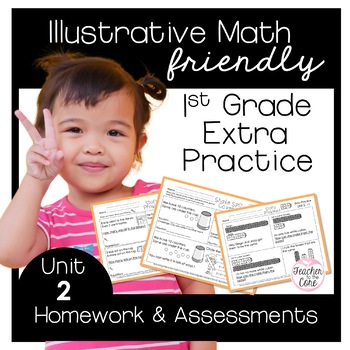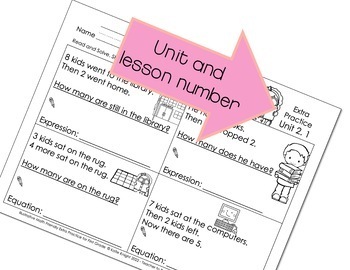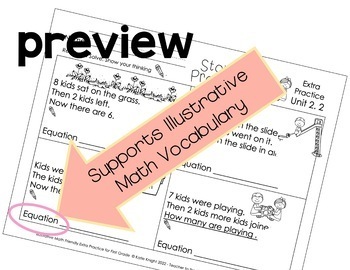Illustrative Math Homework and Assessments Unit 2
Teacher to the Core
12.9k Followers
Grade Levels
1st
Subjects
Resource Type
Standards
CCSS1.OA.A.1
CCSS1.OA.A.2
CCSS1.OA.B.3
CCSS1.OA.D.8
CCSSMP1
Formats Included
- PDF
Pages
22 pages
Teacher to the Core
12.9k Followers
What educators are saying
This has helped me so much. This is my first year teaching Illustrative Math and these sheets are lifesavers!
Amazing!!! This pairs perfectly with the IM curriculum that my school uses for math! I love this kid friendly extra practice! Thank you so much!!
Also included in
- This is a bundle of all first grade Illustrative Math-Friendly Units 1-8. You will have an extra practice for every lesson in the IM math program. 146 practice pages that can be used as year-long:Cool-downs or homeworkUnit 1 - 14 lessonsUnit 2 - 22 lessons Unit 3 - 29 lessonsUnit 4 - 23 lessonsUnitPrice $70.00Original Price $80.00Save $10.00
Description
This resource will help any teacher using Illustrative Mathematics with their need for extra practice / homework / Assessments. This unit has been written by a fellow first grade teacher and is carefully designed to be Illustrative Math friendly with supports for every IM lesson.
Extra Practice / Homework : (See every page in the preview)
- 1 extra practice page per lesson
- 22 lessons in this resource !!!
- Supports vocabulary
- Lesson format is extended here
- Supports game-play
- Can be sent home as homework or used in class
- 4 Assessments Included
- Can be used outside of the IM program as standards-based math practice.
4 Assessments match this extra practice: (See Preview)
- Section A
- Section B
- Section C
- Section D
Will you be making other units?
- Yes!
- I need this extra practice as much as you do!
- I plan to post a unit every few weeks.
What Units are available?
- ⭐ Unit 1 Posted August 25th
- ⭐ Unit 2 Posted Sep 7
- ⭐ Unit 3 Posted Sep 18th
- ⭐ Unit 4 Posted October 1
- ⭐ Unit 5 Posted October 9
- ⭐ Unit 6 Posted October 30
- ⭐ Unit 7 Posted Dec 6
- ⭐ Unit 8 Wahooooo!
Will you bundle?
- ⭐ Unit 1-8 Bundle is posted!
Teachers Like You Are Saying:
- ⭐⭐⭐⭐⭐ Traci D : My students are loving this addition to our math curriculum. I am loving the options to have extra practice for the class or for the few that need the reinforcement. I also love that I have some easy assessments at my fingertips. Another great resource by Teacher to the Core! She has come to the rescue once again!!My students are loving this addition to our math curriculum. I am loving the options to have extra practice for the class or for the few that need the reinforcement. I also love that I have some easy assessments at my fingertips. Another great resource by Teacher to the Core! She has come to the rescue once again!!
- ⭐⭐⭐⭐⭐ Alexis: Katie does it again! This resource is incredibly helpful! If you are a teacher using Illustrative Math this Unit 2 resource is just what you need to help yourself and your students. I really enjoyed using this resource with my students. This resource is a must-have!
- ⭐⭐⭐⭐⭐ Whitney R: This resource is wonderful! It is so great to use with our math curriculum as extra practice, homework, and/or assessments. My students love it. They can easily read the story problems on their own with CVC words/names in the questions and pictures to match each question. Thank you!
Will you bundle?
- Yes, but I will not bundle until all the units are completed.
- After all units are completed price will increase.
- Please enjoy them "hot off the press" until then.
Total Pages
22 pages
Answer Key
N/A
Teaching Duration
1 month
Report this resource to TPT
Reported resources will be reviewed by our team. Report this resource to let us know if this resource violates TPT’s content guidelines.
Standards
to see state-specific standards (only available in the US).
CCSS1.OA.A.1
Use addition and subtraction within 20 to solve word problems involving situations of adding to, taking from, putting together, taking apart, and comparing, with unknowns in all positions, e.g., by using objects, drawings, and equations with a symbol for the unknown number to represent the problem.
CCSS1.OA.A.2
Solve word problems that call for addition of three whole numbers whose sum is less than or equal to 20, e.g., by using objects, drawings, and equations with a symbol for the unknown number to represent the problem.
CCSS1.OA.B.3
Apply properties of operations as strategies to add and subtract. If 8 + 3 = 11 is known, then 3 + 8 = 11 is also known. (Commutative property of addition.) To add 2 + 6 + 4, the second two numbers can be added to make a ten, so 2 + 6 + 4 = 2 + 10 = 12. (Associative property of addition.)
CCSS1.OA.D.8
Determine the unknown whole number in an addition or subtraction equation relating three whole numbers. For example, determine the unknown number that makes the equation true in each of the equations 8 + ? = 11, 5 = ▯ - 3, 6 + 6 = ▯.
CCSSMP1
Make sense of problems and persevere in solving them. Mathematically proficient students start by explaining to themselves the meaning of a problem and looking for entry points to its solution. They analyze givens, constraints, relationships, and goals. They make conjectures about the form and meaning of the solution and plan a solution pathway rather than simply jumping into a solution attempt. They consider analogous problems, and try special cases and simpler forms of the original problem in order to gain insight into its solution. They monitor and evaluate their progress and change course if necessary. Older students might, depending on the context of the problem, transform algebraic expressions or change the viewing window on their graphing calculator to get the information they need. Mathematically proficient students can explain correspondences between equations, verbal descriptions, tables, and graphs or draw diagrams of important features and relationships, graph data, and search for regularity or trends. Younger students might rely on using concrete objects or pictures to help conceptualize and solve a problem. Mathematically proficient students check their answers to problems using a different method, and they continually ask themselves, "Does this make sense?" They can understand the approaches of others to solving complex problems and identify correspondences between different approaches.






